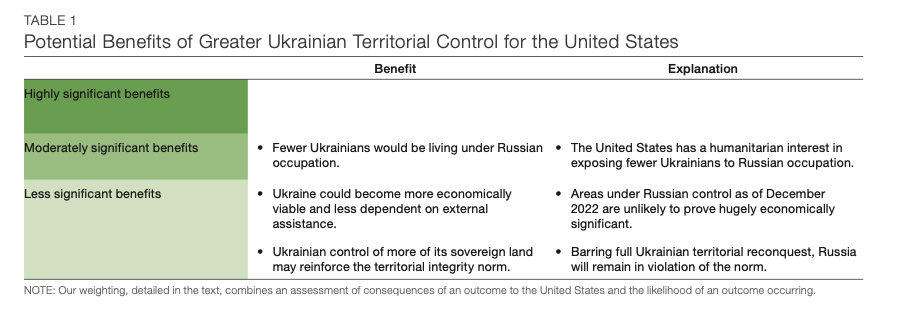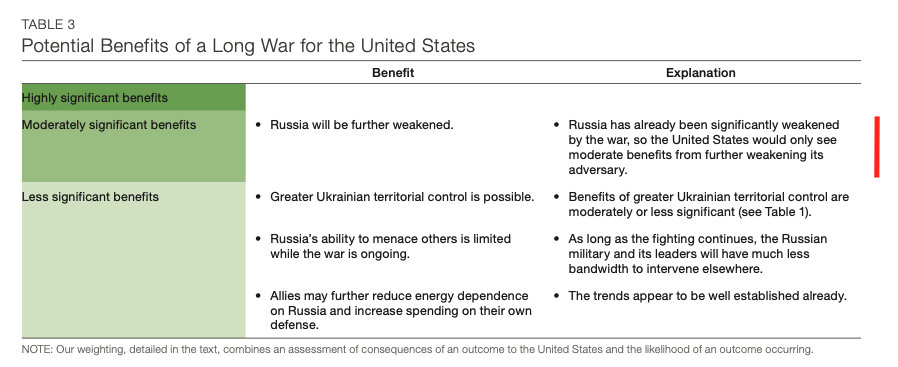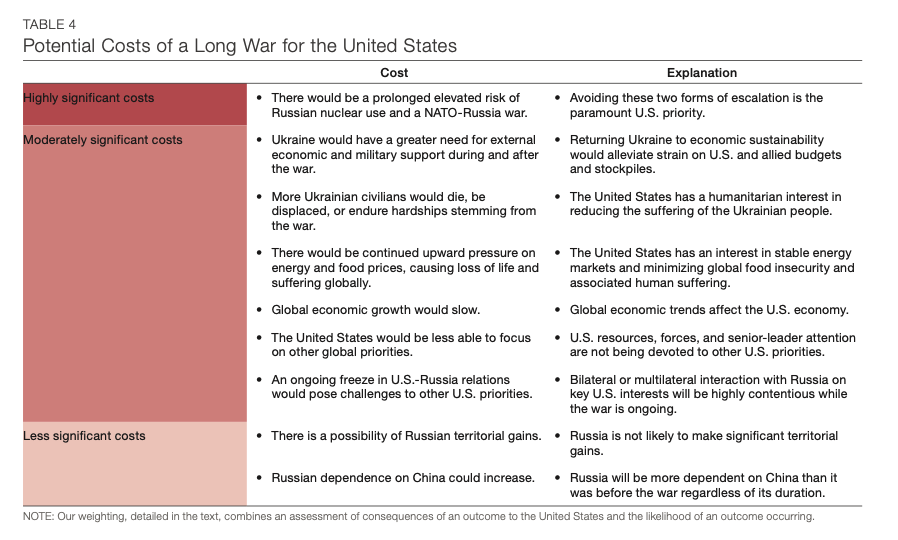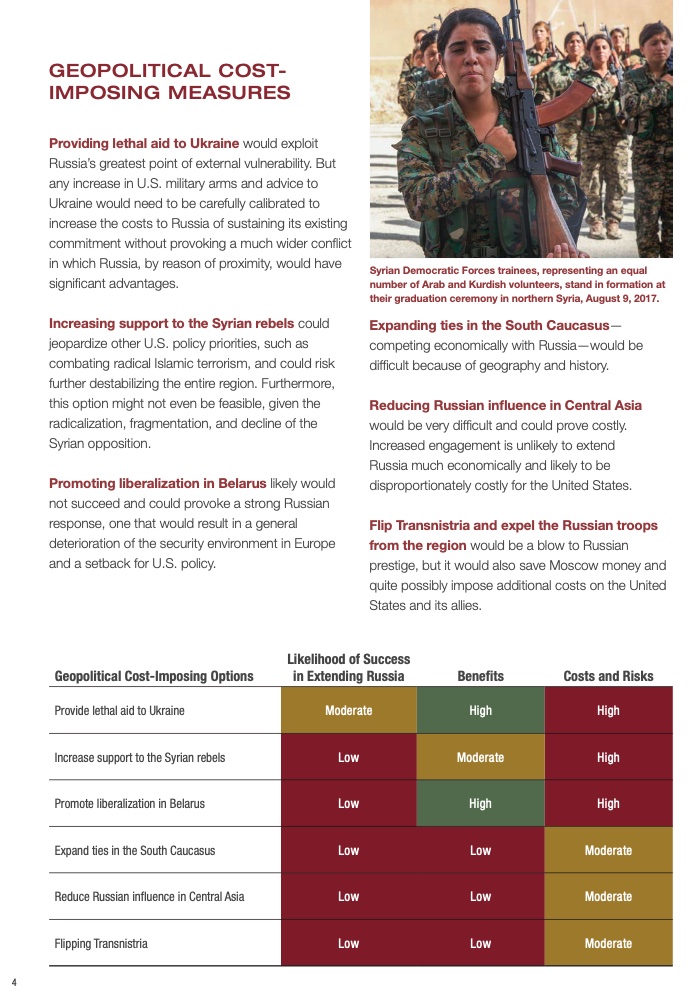On January 25, the Rand Corporation issued a short-ish study of the conflict in Ukraine, titled “Avoiding a Long War: U.S. Policy and the Trajectory of the Russia-Ukraine Conflict.” The Rand Corporation was initially founded as a think-tank that would provide “Research & Development” (R-and-D) advice to the U.S. military and it still remains strongly, though not wholly, focused on military analysis. Thus, this latest study made some waves, especially since its non-hawkish tenor stood in contrast to that of a lengthy (354-page) report that a gaggle of Rand experts released in 2019 that had identified “Providing lethal aid to Ukraine” as a potentially high-benefit way of “Overextending and Unbalancing Russia.”
More about the internal Rand politics of this latest study on Ukraine, later in this essay. For now, let me explain why the study has attracted such attention here in DC. That’s primarily because the authors, political scientists Samuel Charap and Miranda Priebe, boldly asserted that on occasion the interests of the United States are distinct from those of the government of Ukraine. Who would have thought that!!! But for a U.S. political elite that has been drenched in anti-Russianism for the past seven years, and in pro-Ukrainian boosterism ever since last February 24, this is a deeply shocking assertion.
The principal domain in which Charap and Priebe judge that U.S. interests may diverge from those of Ukraine is the matter of whether the United States shares (and whether it should share) the Ukrainians’ desired goal of regaining all the Ukrainian terrain currently under Russian control.
Their study is a quick and easy read and builds on considerable work that each of the co-authors has done on the Ukraine conflict both before and since last February 24. In the study, they examine what they describe as “five key dimensions that define alternative war trajectories” for Ukraine, defined thus:
- possible Russian use of nuclear weapons
- possible escalation to a Russia-NATO conflict
- territorial control
- duration
- form of war termination.
The first two of those topics are non-controversial among most members of the political elite here in the United States. Almost no-one here wants to see either a trip over the threshold of nuclear-weapons use or a direct conflict between NATO and Russia. It is in the latter three domains that Charap & Priebe are aiming to crank a little wider open the “Overton window” of the discourse that’s considered acceptable within the ranks of elite opinion-formers in Washington and New York.
Rand is well-known for its use of Powerpoint-friendly, very basic graphics, and this publication is no exception. So let me just use the block tables that Charap and Priebe use to sum up their main arguments on the issues of territorial control and the length of the war. I guess the tables should all be labeled © Rand Corporation. Also, click on any one of them to enlarge it. Here they are:




That is classic cost-benefit analysis! Notice that in both these dimensions of the war, C&P identify no “Highly significant benefits” to the United States for the scenario in question, while they do identify one or more types of “Highly significant costs.”
Also note in Table 3 that they seem to have bought into the trope that “Russia has already been significantly weakened by the war,” using that to argue that “the United States would only see moderate benefits from further weakening its adversary.” My view, by contrast, is that while Russia has indeed suffered non-trivial losses from the war, those have reached nowhere close to being debilitating. But if we look at a broad, multi-dimensional definition of the global balance between the United States and Russia, then we see that the United States has also suffered losses as a result of the conflict that are significant and continuing, and that may well grow in impact over time. These costs include (but are not limited to) the following:
- raw costs of the US-NATO arms transfers to Ukraine;
- the weakness revealed in US global soft power by Washington’s failure to extend its anti-Russian coalition in any meaningful way into the Global South; and (relatedly)
- the fact that the shock that Washington’s economic measures against Russia inflicted on the world economic system has led many significant economies around the world to strengthen financial and supply-chain linkages that are independent of U.S. control.
Their section on the “Form [or modality] of war termination” is a welcome, but very unsophisticated, attempt to address the basic political issue involved in any armed conflict. A little mechanistically they note that wars can be ended either through the “absolute victory” of one or the other warring party, or by negotiating either a final peace settlement or a battle-zone-wide armistice. Regarding the possibility of an absolute victory—which they note is defined in social-science literature as, “permanently removing the (interstate) threat posed by its adversary”—they write that Russia has probably given up its initial goal of effecting regime change in Kyiv and also, equally realistically, that an absolute Ukrainian victory is unlikely. Puncturing the fever dreams of warmongers in Kyiv or in NATO, C& P state tersely (p.13) that, “it is fanciful to imagine that Ukraine could destroy Russia’s ability to wage war.”
Then, turning to the two different, more or less distinct forms of negotiated settlement, they note (p.15) that, “other things being equal, U.S. interests are better served by a political settlement that might bring a more durable peace than an armistice.” And they very smartly add, “Additionally, a political settlement could be a first step toward addressing broader regional issues and reducing the chance of a Russia-NATO crisis in the future. “
But they conclude this section thus:
However, the level of hostility as of December 2022 between Russia and Ukraine, and between Russia and the West, make[s] a political settlement seem much less probable than an armistice.
Their study then has a section on “Impediments to Ending the Conflict” that addresses a very important question but provides a generally unsatisfactory set of answers. They attribute war-prolongation, in this case and in general, almost solely to an information problem: namely, that the decisionmakers on either side are uncertain about the potential benefits of peace or the potential cost of continuing the war. That is, certainly, nearly always one factor in conflict prolongation. But I spent the first years of my career as a journalist and analyst living in, reporting on, and very closely documenting the initial six years of Lebanon’s lengthy civil war. From that experience, and from the numerous studies I’ve made of a variety of conflicts and conflict-termination efforts since then, I have to conclude that there are two other very important drivers of conflict prolongation. One I would define roughly as “the passions of war”– passions that are certainly strong enough (and probably most especially so within a democracy) to substantially obliterate any rational analysis of costs, benefits, and the advantages of exploring each and every possible avenue for peace. The other would be the concrete economic and other interests of sectors of society that benefit hugely from the prolongation of war. These would be primarily the profiteers in the military-industrial complex, but also include cynical politicians, journalists (whose careers can be catapulted very high, as mine was, by the opportunity to “cover” a war), and other opinion-formers. C&P’s study makes no mention of either of those two important factors.
One other frustrating shortcoming of their paper is that it completely ignores the potential contributions to war-terminating diplomacy that can be played by a wide variety of actors other than the United States. I guess these authors got their professional formation during an era when it was the United States that was the principal driver of all the big shifts in international diplomacy—sometimes with the support of the United Nations, as in some stages of the wars of the Yugoslavia breakup and in Afghanistan; and often-times without, as in the cases of Kosovo, the invasion of Iraq, and numerous other US-led invasions or regime-change operations around the world? And that was also an era in which the United States was the sole or principal actor on the diplomatic stage on such issues as Arab-Israeli peacemaking…
But this time around, as I noted in this assessment that I penned on February 24 itself, the global order is no longer one over which Washington exercises unilateral dominance And in these circumstances it is absolutely both possible and desirable for smart analysts in the United States and other NATO countries to be exploring what role the leaders of other (most likely non-NATO) G-20 countries might be able to play in mediating an armistice in Ukraine that could work for all the parties involved—and beyond that, could work for a world community that has suffered greatly and in many different ways from the outbreak and continuation of the conflict.
… Well, C&P’s study has many analytical shortcomings. But still, it is a welcome addition to a “mainstream discourse” here in the United States that has seen think-tank leaders, most (but thank G-d not all) politicians, and all the high pooh-bahs of the punditocracy lining up to cheerlead for the war against Russia. And as noted above, this study is particularly welcome since it is being issued just four years after the massive study that James Dobbins et al wrote, that identified providing lethal aid to Ukraine as a potentially “productive” way for the United States to “overextend and weaken” Russia. The big Dobbins study was titled “Extending Russia: Competing from Advantageous Ground”. It was a pretty comprehensive-looking, full-spectrum examination of the many ways, both military and non-military, in which U.S. could overextend and weaken Russia.
Nowhere in this 354-page book do the authors explain why they judge that weakening Russia is a desirable goal of U.S. policy. In their Preface, they describes their report in these terms:
This report documents research and analysis conducted as part of the RAND Corporation research project Extending Russia: Competing from Advantageous Ground, sponsored by the Army Quadrennial Defense Review Office, Office of the Deputy Chief of Staff G-8, Headquarters, Department of the Army. The purpose of the project was to examine a range of possible means to extend Russia. By this, we mean nonviolent measures that could stress Russia’s military or economy or the regime’s political standing at home and abroad. The steps we posit… are conceived of as measures that would lead Russia to compete in domains or regions where the United States has a competitive advantage, causing Russia to overextend itself militarily or economically or causing the regime to lose domestic and/or international prestige and influence.
They also never explain why “extending lethal aid to Ukraine”—or indeed, many of the other policies they end up endorsing—should be described as “nonviolent measures.” But let me let that go for now, and content myself with providing one key page from the much briefer (12 pages, full-color) “digest” of the big study that Rand also released at the same time.
Many more handy block-graphs in this study, including on this key page, shown, that assesses potential “Geopolitical cost-imposing measures” that Washington might use. (Click on the image to enlarge it.)
As you’ll see there, “Providing lethal aid to Ukraine” was the first of the six possible steps considered. It was judged as having High potential benefits and risks, and only Moderate chances of success. Also, in the blurb there, they note:
any increase in U.S. military arms and advice to Ukraine would need to be carefully calibrated to increase the costs to Russia of sustaining its existing commitment without provoking a much wider conflict in which Russia, by reason of proximity, would have significant advantages.
The longer version of the Dobbins study devoted seven pages of text to examining the “lethal aid to Ukraine” option. Those pages included a fairly detailed description of the conflict that had arisen between Ukraine and Russia over the situation in Ukraine’s eastern (Russian-speaking) Donbas region—though notably, it made zero mention of the diplomatic process the two countries had engaged in in 2014 and 2015 that had resulted in the two Minsk agreements over the issue.
Anyway, my first question was to ask what had happened at Rand between 2019 and 2023 to lead to such a turnaround in the organization’s stance on Ukraine. I guess I’d have to note at the outset that Rand is a sprawling, very large organization whose many nooks and crannies have different funding streams. The 2019 study was (p.iii),
conducted within the RAND Arroyo Center’s Strategy, Doctrine, and Resources Program. RAND Arroyo Center, part of the RAND Corporation, is a federally funded research and development center (FFRDC) sponsored by the U.S. Army.
The latest study, by Charap and Priebe, by contrast was (p.32):
conducted within the RAND Center for Analysis of U.S. Grand Strategy. The center… is an initiative of the International Security and Defense Policy Program of the RAND National Security Research Division (NSRD)…
Initial funding for the Center for Analysis of U.S. Grand Strategy was provided by a seed grant from the Stand Together Trust. Ongoing funding comes from RAND supporters and from foundations and philanthropists.
And that “Stand Together Trust”? It’s an initiative of the right-wing anti-war mogul Charles Koch, who was also a significant founding funder of the (pro-restraint) Quincy Institute.
So that probably gives us part of the reason for the difference between the stances of Dobbins et al, four years ago, and Charap and Priebe, today. But I’d like to think that if the huge, very mainstream Rand Corporation is now publishing a report that is definitely (though not yet nearly sufficiently) pro-restraint on Ukraine, this could lead to further significant widening of the Overton Window on this crucial issue.
